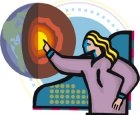
Worksheets and No Prep Teaching Resources
Reading Comprehension Worksheets
Earth Science

Earth Science
 Worksheets and No Prep Teaching Resources Reading Comprehension Worksheets Earth Science |
 Earth Science |
| edHelper's suggested reading level: | grades 9 to 10 | |
| Flesch-Kincaid grade level: | 9.74 |
|
Earth Lab: The Matter
By Trista L. Pollard |

|
 1 Imagine our planet as one huge chemistry laboratory. What would you expect to find? You won't see Bunsen burners and scientists mixing potions. However, if you look closely, you will find that the materials that make up our planet have specific chemical and physical properties.
1 Imagine our planet as one huge chemistry laboratory. What would you expect to find? You won't see Bunsen burners and scientists mixing potions. However, if you look closely, you will find that the materials that make up our planet have specific chemical and physical properties. |
Create Weekly Reading Books
Prepare for an entire week at once! |
| Leave your feedback on Earth Lab: The Matter (use this link if you found an error in the story) |
 |
Earth Science
|
 |
High School Reading Comprehensions and High School Reading Lessons
|